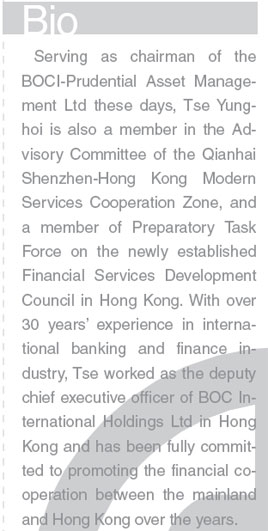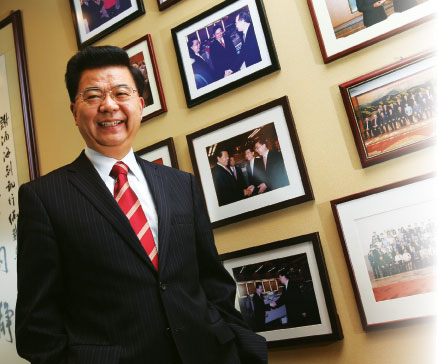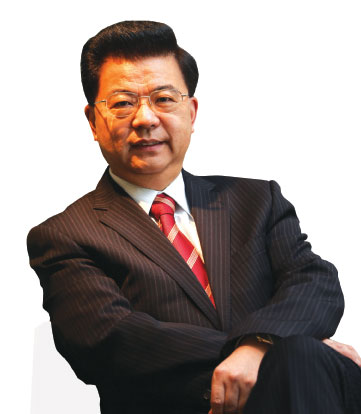South China's 'Manhattan' to bear fruit by 2015
Updated: 2013-01-23 05:52
By Li Tao(HK Edition)
|
|||||||
|
Measures that cover a variety of sectors including finance, taxation, legal, human resources, education, medicine as well as telecommunications are all likely to come out in the first half of 2013 to assist Qianhai's development on a faster basis, said Tse Yung-hoi, chairman of BOCI-Prudential Asset Management Ltd, who is also a consultant in the Qianhai Advisory Committee. All photos: Edmond Tang / China Daily |
Aside from its economic benefits, the greatest value of Qianhai - dubbed South China's Manhattan - lies in its role as an external financial liberalization experiment and demonstration area model, as well as a modern service industry cooperation zone between Shenzhen and HK, to be replicated throughout the whole of China. Li Tao reports.
Since China's State Council announced the approved development and opening-up policies for the Qianhai Shenzhen-Hong Kong Modern Service Industry Cooperation Zone in mid-2012, the 15-square-kilometer area in the western coast of Shenzhen - in the forefront of China's reform - has come under the world's spotlight ever since.
It is still early to associate the traditional small remote part of Shenzhen that used to be a piece of muddy reclaimed land with the immense title of being a test ground for the next set of financial innovations in China, the world's second largest economy, as what we've seen today remains still a scene of infrastructural developments in full swing.
But, imagine that Qianhai's output volume is estimated to reach 50 billion yuan in 2015 - only two years from today, on such a tiny piece of land area where the gross domestic product (GDP) is projected to further triple to 150 billion yuan by 2020, putting the Qianhai enterprises' productiveness ahead of all other areas in the country by then, according to Tse Yung-hoi, chairman of BOCI-Prudential Asset Management Ltd.
Tse, who also served as a consultant in the Qianhai Advisory Committee, told China Daily that Qianhai's significance lay far beyond the economic benefits it produced, in that the area's value was in its testing roles as an external financial liberalization experiment and demonstration area, as well a modern service industry cooperation zone between Shenzhen and Hong Kong.
Not Lujiazui's replica
Although dubbed "South China's Manhattan" with the aim of strengthening the collaboration between Hong Kong and Shenzhen as well as the whole Pearl River Delta (PRD), Qianhai's role in the national economic development landscape, in essence, will be distinguished from that of Lujiazui Financial and Trade Zone in Shanghai, Tse said.
In the very beginning, the State Council has declared that the experimental policies that are even "more special" than policies adopted in special economic zones will be complemented in Qianhai on a trial basis.
The central government designated 22 pilot policies specially for the area in June last year, including eight related to financial innovations, while the rest are other supporting initiatives, highlighting the government's objective to support experimental activities in financial reform and innovation in the area.
Cutting-edge financial innovative policies include diversifying channels for the reflux of overseas yuan capital to develop the offshore yuan business in Hong Kong and to position the territory itself as an innovative and experimental hub for cross-border yuan-based business. Qualified enterprises and financial institutions established in Qianhai are also encouraged to grant yuan loans for offshore projects.

But the distinctive position and pioneer role of Qianhai, even if blessed with tons of favorable policies from the government, has also brought about risks of failures on the tryouts particularly when many of these policies will touch the nerves of reforms in many sectors in China.
"We've seen Shenzhen becoming China's most successful special economic zone, and we've also seen other unsuccessful examples that failed to stand out during China's economic reform and opening up (of the country)," said Tse.
By 2020, China's financial hub, Shanghai, will be positioned to become an international financial center by the country's top economic planner with its economic weight and currency taking a more prominent position on the world stage.
At the heart of Shanghai's economy, the future of Lujiazui Financial and Trade Zone is de facto crucial to the country given its close associations with the overall national economic development of China, making the prospects of losing Lujiazui unaffordable.
Although Qianhai's economic significance is incomparable with Shanghai's Lujiazui, the successful tryouts in Qianhai are nevertheless crucial to the whole country given its independent and particular role in exploring the further liberation of the Chinese economic environment to the whole world, according to Tse.
"Qianhai, a leader in the financial industry that is developing into a modern services industry, is also powered by cooperation between Shenzhen and Hong Kong in producing a demonstration effect for the country as a whole. It may play the role that Shenzhen did 30 years ago," said Tse.
Qianhai zone devt
On Dec 28, 2012, the Shenzhen branch of the People's Bank of China announced that companies in Qianhai were permitted to get yuan loans from financial institutions in Hong Kong - marking the start of the introduction of more detailed implementation of these innovative policies issued upon Qianhai zone's further development.
It is the first detailed official annotation of the 22 pilot initiatives endowed on Qianhai. Further policies on 21 other measures that cover a variety of sectors including finance, taxation, legal, human resources, education, medicine as well as telecommunications are all likely to come out in the first half of 2013 to assist Qianhai's development on a faster basis, Tse told China Daily.
The mainland authorities lowered the eligibility requirements and access criteria for Hong Kong enterprises for setting up and running modern service businesses in Qianhai within the framework of the Mainland and Hong Kong Closer Economic Partnership Arrangement (CEPA).
Besides some bold attempts in the financial markets that allow freer capital flows between Hong Kong and Qianhai, from the legal aspect, Hong Kong arbitration institutions will also be permitted to set up branches in the Qianhai Zone. Tax reform for the modern services industry will also take place, where waiver of business tax, preferential corporate tax rate and discounted individual income tax will be implemented in Qianhai specifically.
Equipped with all these preferential policies, the government has also mapped out master plans to complete the Qianhai development in 10 years through three stages.
After the start-up period between 2010 and 2012, which primarily prepared general guidelines and infrastructure developments, the second stage which commences this year until 2015, will conduct substantial investment invitations and begin generating economic benefits in the area, said Tse.
As of August 2012, the experimental zone had collected accumulated investment intentions worth 300 billion yuan, right after the official announcement of the zone's approval from the central government. Over 70 companies from the Fortune 500 have showed interest to station in the district so far, according to Tse.
By the end of 2015, the Qianhai special zone aims to reach a GDP of 50 billion yuan.
In 2020 - at the end of the third development stage starting in 2016, which also marks the completion of the construction of a world-class modern service cooperation zone, Qianhai is tipped to become a regional production-based service center and the base of world trade for services, with GDP expecting to exceed 150 billion yuan every year.
Qianhai could become the area which makes the most money on every square meter in China, considering the hundred billion yuan to be generated from the pinhead 15-square-kilometer area, said Tse.
"Its business model is basically a clone of the Central to the Causeway Bay area in Hong Kong," Tse added.
Qianhai's significance
As the first experimental zone of the country's modern service industry, Qianhai's gains and losses in its trial developments will provide valuable references for the whole nation as the services sector is playing an increasingly important role in China's economic growth, said Tse.
Government data shows that China's tertiary industry accounted for 43.1 percent of the country's GDP in 2011, compared with 40 percent in 2005. Besides the weighing contribution to the country's economy, the strengthening of the service sector will generate more jobs, a crucial factor for the country along with its urbanization pace, Tse said.
After years of fast economic growth, the importance of the financial sector in the whole economy has become increasingly notable and it has also boosted growth of many supporting sectors in China these days.
"But the financial industry today is also the bottleneck of the further development of China's economic growth," said Tse.
"On the one hand, the mismatch of resources and non-market-oriented interest rate mechanism allowed banks to obtain huge profits in China. But on the other hand, the immature capital market on the mainland that leads Chinese banks to become the main sources of fundraising activities by enterprises has also imposed huge potential risks on these lenders," added the banking veteran who has served in the industry for decades.
Liberation of interest rates and the yuan's exchange rates will witness breakthroughs in the zone as eligible enterprises in Qianhai will be allowed to raise money from Hong Kong lenders at market prices. Banks in Qianhai are also encouraged to grant yuan loans for offshore projects, according to the zone's initiatives.
As enterprises in Qianhai will also be allowed to issue yuan bonds in Hong Kong, the move will also provide references for the country to build a multi-level bond market in the future, where bond issuances remain a government activity while companies are still short of ways for fund-raising besides bank loans, according to Tse.
But potential risks rising from these innovative experimental activities in Qianhai should be strictly constrained in the area, Tse believes. "Other than a branch of other companies, an enterprise established in the economic zone needs to be an independent entity which will not be subject to the administrative interference from other places."
"Qianhai's enterprises should also prepare two sets of separate accounts for business activities, within and outside the territory for supervision, in a bid to prevent Qianhai becoming the springboard for hot money inflows in the country," he added.
Given that financial institutions and enterprises located in the area will be able to conduct both domestic and cross-border activities on a freer basis, Tse also calls for the establishment of a "super-regulator" in the special area with functions of banking, securities as well as insurance regulatory authorities to regulate enterprises in Qianhai.
Hong Kong opportunities
Although the business model of Qianhai has inevitably coincided with Hong Kong to some extent, the small pilot economic zone will not jeopardize the advantageous positions of the city, but will provide tremendous opportunities for Hong Kong, even beyond those from Qianhai itself, said Tse.
Hong Kong has seen explosive yuan deposit growth over the years. The further relaxation of currency flows between Qianhai and Hong Kong has offered another channel for yuan's investment and management among local lenders in the city, according to Tse.
The city, which is poised to become the leading offshore yuan financial center in the world, should consider boosting the varieties of yuan products including bonds and stocks. It should also sort out ways to widen yuan usages in the real economy to enhance the currency's liquidity in daily life.
Meanwhile, despite China's consumption of commodities including gold and copper topping the global market, the country still lacks involvement with global commodity pricing. Tse believes that Qianhai's innovative role may also affect the international commodity pricing.
But the long-term significance of Qianhai's development for Hong Kong definitely lies far beyond the neighboring 15-square-meter area.
"Think of Qianhai's experimental activities today as mirroring the future business connections between Hong Kong and the whole mainland," said Tse.
"If Qianhai is able to explore the possibilities of establishing channels for large commodity transactions or precious metals warehousing, the commodities trading center may be able to transfer from London to Hong Kong, which will benefit both the city and the development of the domestic commodity market on the mainland," Tse added.
|
According to Tse, over 70 companies from the Fortune 500 have showed interest to station in Qianhai so far. |
(HK Edition 01/23/2013 page4)

